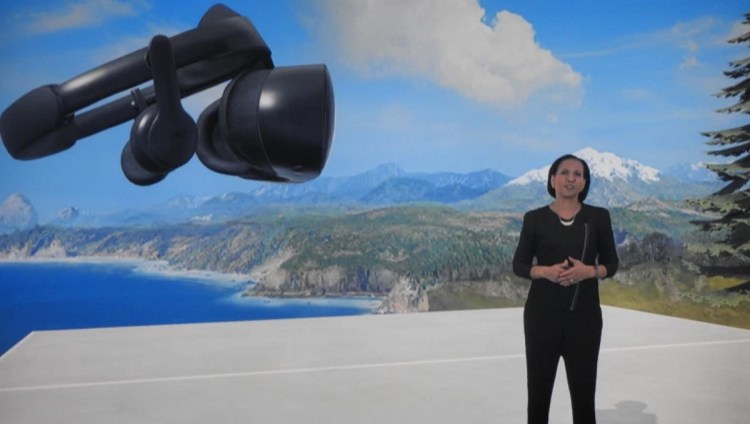Microsoft held its mixed reality event in San Francisco today, where it unveiled its ecosystem for Windows-based virtual reality and augmented reality experiences.
Samsung revealed its own PC-based VR device, the Samsung HMD Odyssey, as a complement to its Gear VR smartphone headset. I tried it out briefly and navigated through Microsoft’s Cliff House virtual space interface.
Like the headsets from Oculus and HTC that preceded it, the Windows-based device lets you teleport from place to place with the virtual environment. That’s much easier than trying to virtually walk through a space, as that can make you dizzy. To teleport, you simply press the trackpad on the motion controller in your hands and a guide indicates where you will move when you let go of the trackpad.
You can also pull a trigger or press buttons on the hand controller to move around or drill down on a particular demo. I briefly went into Funomena’s Luna demo, which is a pretty VR game about a little bird that has to find its way home. I touched tree branches and stars with my hands in the virtual space, and it transported me to another world. Luna looks beautiful in VR, with its blending of a cartoon art style and 3D graphics so you can see objects from any view.

Above: Samsung HMD Odyssey VR headset will cost $500.
I also tried out Halo Recruit, a very basic introduction to the Halo universe in VR. You are welcomed into a sci-fi training facility where you are first shown the enemies from the Covenant, ranging from small grunts to huge Elites. Seeing these characters in virtual reality for the first time gives you a sense of just how tall the Elites are.
Then I went into a kind of shooting gallery. I wielded two pistols, one in each hand. I could independently shoot those weapons at different targets. The Covenant enemies appeared and I started firing away. I had to shoot simple orange bullseye targets that appeared over the enemies within the time limit. The graphics were smooth, and they were up to par in terms of what I would expect for a Halo game.
The targets were big, and they allowed for a very large margin of error in terms of targeting. It’s not precise like you would expect in a Halo console or PC 2D-screen experience. It really was just a demo to show what is possible, said Kiki Wolfkill, an executive producer and one of the Halo leaders of 343 Industries at Microsoft.
It is a very casual shooting experience, aimed at those who are new to Halo. I was able to get Spartan status, the highest possible, in my first round of shooting. But I only hit my targets 35 percent of the time, as I was doing a spray-and-pray kind of shooting. Clearly, there’s room for improvement.
I felt comfortable throughout the experience and had no bouts of dizziness or discomfort. I wasn’t even sweating at the end of the 7-minute demo. And that’s part of the whole message: that VR doesn’t have to be a difficult experience. Microsoft has made the setup easy and the time to get into VR experiences quite short.
Alex Kipman, tech fellow at Microsoft and host of the event, said there are 20,000 Windows apps in the Windows app store that you’ll be able to use in VR or AR, starting on October 17, after Microsoft launches its Fall Creators Update for Windows 10. But most of those apps are meant to be viewed in 2D. You can use apps like Powerpoint in mixed reality, but there isn’t much point in doing so.
Overall, the hands-on experiences that were available at the event, as well as Kipman’s talk, were consistent with the notion that Microsoft wants to bring mixed reality to the masses, with comfortable equipment, easy navigation, and affordable prices.

